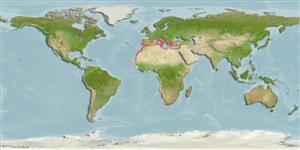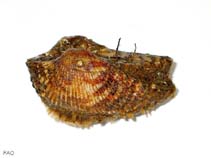Arca noae Linnaeus, 1758
Noah's ark| Native range | All suitable habitat | Point map | Year 2050 |

|
| This map was computer-generated and has not yet been reviewed. |
| Arca noae AquaMaps Data sources: GBIF OBIS |
Classification / Names Common names | Synonyms | CoL | ITIS | WoRMS
Bivalvia | Arcida | Arcidae
Environment: milieu / climate zone / depth range / distribution range Ecology
Benthic; depth range 0 - 200 m (Ref. 2754). Subtropical; 46°N - 17°S, 17°W - 36°E
Distribution Countries | FAO areas | Ecosystems | Occurrences | Introductions
Eastern Atlantic and Mediterranean Sea.
Length at first maturity / Size / Weight / Age
Maturity: Lm ?, range 2 - ? cmCommon length : 10.0 cm SHL male/unsexed; (Ref. 437); max. reported age: 16 years (Ref. 7879)
Minimum depth based on ecology. Abundant in coastal waters (Ref. 73156). Occurs from the low intertidal to a depth of 119 m (Ref. 122977). Also found in a coastal lagoon (Ref. 122976). Firmly attached by a strong byssus to rocks, shells and rhizomes of the seagrass Posidonia oceanica (Ref. 122975). Occurs either as solitary individuals. Attaches to rocks covered with photophilic algae and nestles in rock crevices and holes in loose stones; also occurs on various kinds of semi-mobile gravels (Ref. 122977). Associated with coralligenous assemblages, i.e. temperate reefs of the Mediterranean (Ref. 122117).
Life cycle and mating behavior Maturity | Reproduction | Spawning | Eggs | Fecundity | Larvae
Life cycle: Embryos develop into free-swimming trocophore larvae, succeeded by the bivalve veliger, resembling a miniature clam (Ref. 833).
Main reference
References | Coordinator | Collaborators
Fischer, W., G. Bianchi and W.B. Scott (eds.). 1981. (Ref. 437)
IUCN Red List Status (Ref. 130435)
CITES status (Ref. 108899)
Not Evaluated
CMS (Ref. 116361)
Not Evaluated
Threat to humans
Human uses
Fisheries: commercial
| FishSource |
Tools
More information
Internet sources
BHL | BOLD Systems | CISTI | DiscoverLife | FAO(Publication : search) | Fishipedia | GenBank (genome, nucleotide) | GloBI | Gomexsi | Google Books | Google Scholar | Google | PubMed | Tree of Life | Wikipedia (Go, Search) | Zoological Record
Estimates based on models
Preferred temperature
(Ref. 115969): 11.9 - 17.5, mean 15 (based on 28 cells).
Resilience
(Ref. 69278):
Medium, minimum population doubling time 1.4 - 4.4 years (K=0.15-0.34; tmax=16).



